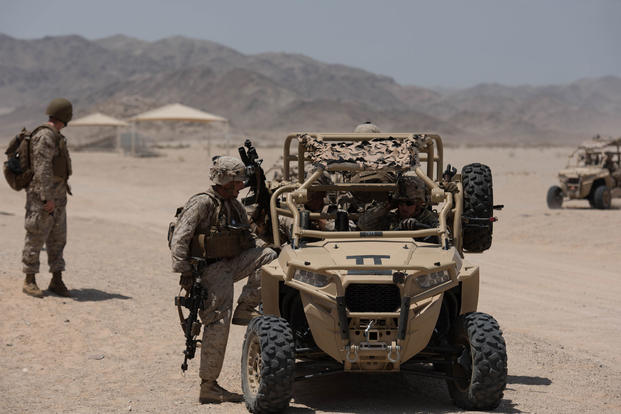Early results of a new Marine Corps force structure assessment show the service could use about 8,000 more troops than are budgeted, a reflection of a demanding operating environment and the need to to grow cyber and other technological capabilities.
Lt. Gen. Robert Walsh, commander of Marine Corps Combat Development Command, told Military.com in an interview this month that the Marine Corps would like to grow to 190,000 troops, though officials are moving forward with a "constrained" strategy that takes into account the current force of 182,000 Marines.
"The path we're on is to go to 182,000 Marines," Walsh said. "That's what we're going to be funded for; that's what we're allowed to do by Congress. But in a perfect world … we came up with about 190,000; that is the optimized force."
This is an increase from the Marine Corps' last force structure review in 2010, which found the ideal size for the force was 186,800. The service was then planning a drawdown from a wartime peak end strength of 202,000. Ultimately, budget constraints dictated a steady-state end strength of 182,000, which the Marine Corps is set to reach this year.
The Marine Corps recently completed a series of war games on the East and West coasts that tested out various unit sizes and battlefield strategies. Part of an initiative called Force 2025, the approach allowed Marine brass to workshop competing operating concepts with officers from around the Corps and test them in a simulated combat environment.
Two perspectives ultimately emerged, Walsh said: an optimized course of action that would employ 190,000 and a constrained course of action that would strategically employ the force at its current end strength.
Among the wish list items in the optimized plan are a deployment-to-dwell ratio of one month deployed for every three at home, rather than the current one-to-two; increased information warfare capability; more resources for the Marine intelligence community; improved precision fire at longer distances; portable device technology that could communicate with new F-35B fighter jets; and rebuilt Marine Expeditionary Force headquarters improved for the current operating environment.
"We didn't say, 'Let's go to Congress and say we want that.' Somebody may give that to us as we go to the next administration and take a hard look or the operating environment might drive us," Walsh said. "What we'll be able to do is if somebody says, 'Hey, if you've got some money, got more force structure, what would you buy?' We now have conducted a force structure assessment that would allow us to do that."
For now, the Marine Corps is working to get the most out of the manpower it has by leveraging technology to employ its forces differently.
In August, the service announced the launch of Sea Dragon 2025, a series of wargames and experiments that will take place over the next 12 months to test new ideas, concepts and employment of gear.
During the first Sea Dragon event, Marine Integrated Experiment 16, held at Marine Corps Air-Ground Combat Center Twentynine Palms, California, in August, troops integrated drones and robotic vehicles into infantry squads of various sizes to determine how the technology could improve the teams' effectiveness.
During the next event, a pre-deployment integrated training exercise, the same unit -- 3rd Battalion, 5th Marines, the Corps' designated experimental element -- will configure its three companies in different sizes to further explore capacity.
Walsh said the Corps was still evaluating the results of MIX-16 and the findings regarding the right size for infantry squads moving forward. The experiment did confirm an emerging perspective about squad leadership, he said.
"We absolutely learned, with all this technology we're using, we need an assistant squad leader," he said. "We've defined that whatever size we're going to be at, whether it's 10, 12, 13 or 14, one of those Marines is going to be an assistant squad leader that can help the squad leader with the technology, decision making, being able to process all that information in, so the squad leader [can continue] to manage and run his squad."
The experimental unit will be central to the Sea Dragon exercises through its deployment to the Western Pacific aboard the 31st Marine Expeditionary Unit late next year. Walsh said the unit would deploy with a number of the devices it used in stateside exercises, including unmanned aerial systems, tablets and compact expeditionary vehicles.
"By leveraging those capabilities, you maybe don't have to be as large of a force," Walsh said. "You can operate smaller, in a more distributed manner in different ways, to be able to operate differently."
-- Hope Hodge Seck can be reached at hope.seck@military.com. Follow her on Twitter at@HopeSeck.



























